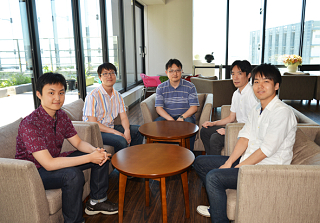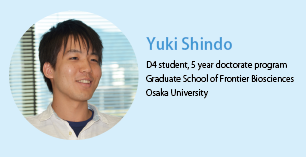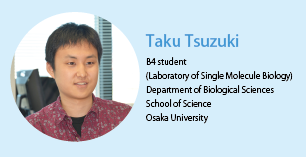Shindo I was surprised to hear that the order of computation has increased by 2-3 digits due to the emergence of the K computer but there had been no high-performance MD software that can work on the K computer. How much has the computational scale for MD simulations been improved by the K computer?
Sugita The largest scale we had tackled before the emergence of the K computer was 300,000 atoms, I guess. However, the number of atoms that we can handle with the K computer is more than 100 million. Actually, one or two proteins have been simulated previously, but now a system with approximately 200 proteins can be computed at the same time.
Shindo How many seconds has the computation been shortened by?
Sugita In fact, it's not so much. 100 nanosecond MD simulations have been performed before the K computer was available, but now it's still microseconds on the K computer. It hasn't increased by 100 times. Approximately 10 times, I suppose. One individual CPU of the K computer is not so fast, and the computational speed is improved only by using them in parallel. Altogether, computation is improved along the space axis rather than the time axis. Computation speed is much faster if we use "GENESIS GPGPU version", which is now under development by Dr. Jung.
Tsuzuki You said you are now able to treat a large number of proteins. Have you made new discoveries with this improvement?
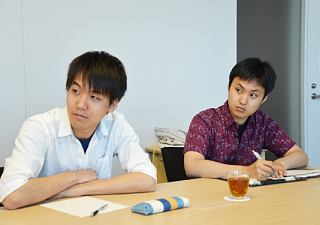
Sugita So far, we have analyzed behaviors of proteins in low concentration, namely, in vitro. However, as you may know the term "in-cell NMR" in structural biology, it is now possible to put cells in an NMR tube and analyze structures of biomolecules such as proteins in cells. Interestingly, recent simulation studies showed good agreements with such experiments. I think we are going to be able to understand whether proteins are stable, I mean, they do not change their structure or not, and how they interact with drugs and ligands in high concentration environments like cells.
Tsuzuki So it means now we can directly compare simulations and experiments.
Sugita
Yes. A new field such as "in-cell MD" may be emerged by further research.
How much do you need to expand the scale of computation to reach the goal?
Tsuzuki So you aim to reproduce one cell perfectly by MD.
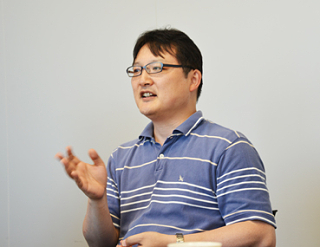
Sugita Well, it depends on the cells you want to understand. Our current target is Mycoplasma genitalium. At this moment, we are performing simulations for about one-tenth of the cytoplasm in volume. Judging from this scale, modeling of the entire system will be realized quite soon. But there is a difficulty in such a whole system modeling. There are membranes in the cell. The structures of membrane proteins of Mycoplasma genitalium have not been sufficiently revealed. This makes the matter even more difficult. When it comes to eucaryotic cells, although they are more important than bacteria, it must be more challenging. It’s hard to imagine the scale of the simulation. Even Escherichia coli is larger and more complicated than Mycoplasma genitalium. Such research should be a tough work but young researchers, including me, should explore unknown world rather than study in the world already investigated. Then, I think, we can enjoy research for a long time. In this regard, I believe this is a good theme. Please take up the challenge!
Tsuzuki Yes.
Shindo I've just heard that Dr. Mori is studying biological membranes. I think structures of biological membranes can vary due to changes of physiological conditions or environments. Did you have any difficulties in simulating biological membranes using the REMD method?
Mori
It's a good point. If we apply the temperature REMD method to biological membranes, there is a possibility that the membrane collapses due to high temperature. The surface tension REMD method I developed is one method to overcome this problem. In this method, we do not assign different temperatures to each replica, but give surface tensions as parameters to be exchanged.
Since the surface tension is a force that reduces the surface area, the membrane expands or shrinks horizontally when surface tensions are exchanged. This method can induce structural changes of molecules in the membrane without exchanging temperatures. We have to sometimes use different techniques to simulate biomembranes, because properties of soluble proteins and membrane proteins are different.
Shindo You just said that it is difficult to handle biological membranes of Mycoplasma genitalium. Do you mean that it is difficult to reproduce the membrane structure?
Sugita The difficulty in modeling the entire cell is due to that structures of membrane proteins have not been sufficiently revealed. Of course there is a complexity in the membrane structures themselves. For example, do you know how many types of lipids are there in membranes? Actually so many. There are as many as proteins. In the biological membranes, many different lipids and proteins are quite mixed.
Tsuzuki
I suppose your purpose is not only to simulate single molecules, but eventually also to understand protein-networks that emerge from existence of different kind of proteins.
I think interactions between molecules need to be clarified. How well do you think you can do this at the present time?
Sugita At the moment, we hardly describe any of them. If structures of proteins in isolated and complex forms are clarified, we can evaluate the interactions. However, the accuracy for the prediction of the complex structure is not good at present. This is one of the important subjects that we have to work on in future.
Tsuzuki What kind of techniques can we use to predict intermolecular interactions?
Sugita I think there are some choices. But, in my opinion, there are mainly two methods. One is using our original method, the replica-exchange method. We should improve the method more and more in order to apply it to protein-protein docking problems. This is one of the subjects we wish to try in the near future. The other is to develop a new molecular model. We usually use all-atom models, in which all the proteins, DNAs, water and ions are piled up from atoms, while we are also working on coarse-grained models and monomolecular models with hydrodynamic interactions. In the former model, one residue in the protein is approximated to one particle. The computation cost can be reduced by coarse-graining. We wish to improve its accuracy, and create, how I say, a "large-scale, highly precise coarse graining model" by such an approach. Basically, the accuracy decreases by coarse graining from atomic resolution to low resolution, while we improve the accuracy within the low-resolution model as much as possible. Further, we expand the model to large-scale systems with massively-parallel computation. Then, we call it a "large-scale, highly precise coarse graining model".
Tsuzuki May I ask you the last question? I was just wondering how you consider time series of the system in REMD simulations. What we can obtain by this method is just a probability of each state, and it seems to be impossible to compute time evolution of the system. How do you apply the method to compute the time evolution?
Sugita
Basically, we do not consider time series in REMD simulations. We need two quantities for MD computation. One is kinetics, which requires an analysis of time series. And the other one is thermodynamics, which are mean values. The mean value is, for example, a kind of ratio like 6:4 of two states. We do not consider how long it takes for the conformational transition between two states. The REMD method provides such mean values more precisely.
If we want to see time series, we should perform a long MD simulation.
Tsuzuki I see. Thank you very much.
